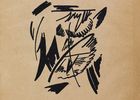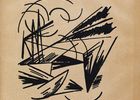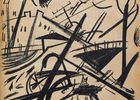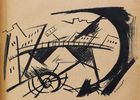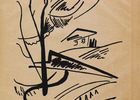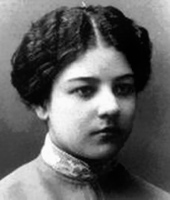
Artist,
art theorist and representative of Russian avant-garde.
She
finished an all-girls school (Russian gymnasium)
in Vladimir (1904) to continue her studies in Moscow at the Stroganov Arts and
Technical School and private studios run by Konstantin Yuon and Ivan Dudin. She
attended courses at A. P. Bolshakov’s Painting and Sculpture school
(1907-1910), and also studied at Elizaveta Zvantseva’s Art School in St.
Petersburg (1911). Rozanova was a member of a number of associations: Soyuz Molodezhy [“The Union of Youth”] (1911-1914)
whose manifesto she authored, Bubnovy
Valet [“The Jack of Diamonds”] (1916-1917)
and Supremus (1916-1918). She
participated in the avant-garde exhibitions by Soyuz Molodezhy (1913), “Women
Artists to War Victims” (1914), “Tram
B” and “0, 10” (1915-1916). The avant-garde artists - Alexey Kruchenykh, Velimir
Khlebnikov, Kazimir Malevich, Mikhail Matyushin and Elena Guro – exerted a
strong influence on Olga Rozanova. She expressed, in her own way, many ideas
and theoretical postulates of the various artistic trends of the 1910s –
cubism, futurism, primitivism and suprematism. She worked in various
techniques: oil panting, graphics, book illustrations, lithography, linoleum
engraving, and collage, and contributed to lithographic publications.
The
first illustrations were made for Rykayuschii
Parnas [“Roaring Parnasus”], a futuristic
collected works volume (1913), Bukh
Lesynii and Vzorval
[“Explosion-ness”] (1913) – futuristic books by Alexey Kruchenykh. She applied linocut
and collage techniques in Kructenykh’s book
Utinoye gnezdyshko…durnykh slov [“The Duck’s nest …of Mean Words”] (1913) and
Khlebnikov’s Te lee le (1914). Her
colour linocuts are to be found in Voyna [“War”]
by Kruchenykh and Igra v adu [“Playing
in Hell”] co-authored by Alexey Kruchenykh and Velimir Khlebnikov (1914-1915).
She also took part in designing Alexey Kruchenykh’s books Chort i rechetvortsy [“The Devil and the Speech-Writers”], Stikhee Mayakovskogo. Vypyt, [“Mayakovsky’s Poems.Vypyt”], Zaumnaya Kniga [“The Highbrow Book”], Vozropschem [“Let Us Repine”] and
others. Influenced by Alexey Kruchenykh’s ‘highbrow language’, she took up
poetry. In 1917-1918, she worked at objectless compositions which she called tsvetopis (“colour painting”).

